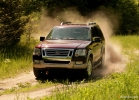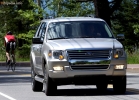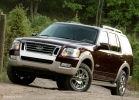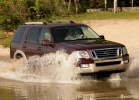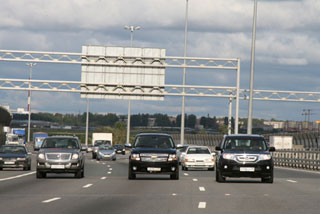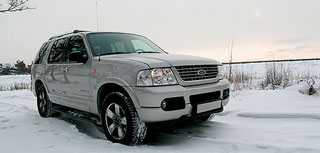Ford Explorer test drive since 2005 SUV
Renovationists
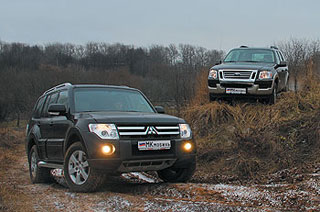 The great thing is cosmetics!
The great thing is cosmetics! It is only necessary to thoroughly process the front of the car, leaving other body elements practically unchanged, and a new model is ready. It was in this way that the creators of the radically updated Ford Explorer and the fourth generation Mitsubishi Pajero were going on.
Thanks to the new optics and the Ford Explorer false radiator lattice, which had undergone serious restyling back in 2005, but reaching Russian fans with a two -year late, is noticeably different from its predecessor. Meanwhile, discarding the difference in appearance and the processed interior, we, by and large, are dealing with the same Explorer sample of 2002. The above, in principle, is true regarding Mitsubishi Pajero IV. The lines of the body remained almost the same, but the blowing front arches that once caused bewilderment sunk into oblivion. Family a step on the lower edge of the Former Famile feature of all Pajero, except for the third, found a legitimate place. In general, thanks to the minimum innovations, the appearance of the car has become more strict, restrained and elegant. But is it fair to talk about the new generation of the car? A light correction of appearance and the expansion of the list of options should be carried out under the flag of restyling.
The interior of Explorer was noticeably Europeanized. For the sake of fastidious inhabitants of the Old World, the Americans transferred the automatic transmission selector from the steering column to the floor and even slightly formed the seats, giving them some semblance of stiffness at the same time. By the way, the buttons knowing the heating seats should no longer be frantically searching for the entire cabin (before they were located next to the keys of the seats, and now, in sight, at the base of the central console). However, the traditional footstand of the parking brake and the only overloaded with the functions of the steering wheel switch, alas, did not disappear.
So, behind the wheel of Pajero, the average European will be more convenient. After all, everything is in the usual places. And the interior itself pleases not only with functionality, but also in the style and the quality of the finish. In addition, there is a highlight in the Hi-Tech style large Touchscreen-display on the central console. True, the inconsistent came out with him: in sunny weather, the screen becomes almost unreadable. And it’s a pity, because they are tied to him
multimedia entertainment system, navigation map and picture from the rear view camera.
The driver’s places of our heroes are allowed both to the commander’s landing (high and close to the steering wheel), and a relaxed relaxed range of adjustments of the seats is quite large for SUVs.
There are almost no significant ergonomic punctures: the only serious claim to both participants in the test is the absence of a steering column adjustable for departure.
Passengers, to whom our heroes are very friendly, will not be complained. Three adults are placed in the rear sofas (the exception is Explorer in the top version of Limited, where the rear sofa is made in the form of two individual chairs, separated by a huge boxing box). And together there are no problems at all: the legs for the legs are in abundance even for a very tall driver, and the feet easily fit under a high pillow of the front chair. True, tall passengers will feel a lack of air above their heads (this is especially noticeable in cars with a hatch in a hat here). But if desired, the back of the seat can be thrown back and travel reclining.
In addition to the second row of seats in the Ford and Mitsubishi salons, there is a third, extracted if necessary from under the floor of the luggage compartment. Electric drives come to the Explorer Limited, and the owner of the less sophisticated version of Eddy Bauer (like the owner of Pajero) is forced to do it manually. Moreover, it is difficult to transform the Japanese salon, without first looking into the operating instructions. But what can you do for the sake of children because in luggage places it is convenient only for them.
In the Ford Explorer range, two gasoline engines: a 4.6-liter 296-horsepower V8, aggregated with a six-speed adaptive automatic machine, and a 4-liter V6 with a capacity of 213 hp. Paired with AKP-5. The handout controlled by three buttons at the central console provides three modes. By default, 4x4 Auto is turned on (the main drive is the rear, and the front bridge is connected if necessary through a friction clutch with electronic control). And 4x4 are provided for off -road (both bridges work, but the value of the moment transmitted to the front is changing according to the situation) and 4x4 LOW (the same, but using a lowering transmission).
Mitsubishi Pajero offers a 3.8-liter 250-horsepower V6 and 3.2-liter 165-horsepower diesel. Moreover, the six is \u200b\u200bavailable only with a 5-speed automatic, and a five-speed manual gearbox and automatic are provided for a turbodiesel. The handout is controlled by the handle to the right of the automatic transmission selector and offers four basic modes. In position 2n, Pajero is rear -wheel drive. The 4H mode connects the front bridge. And not hard, but through the center differential: with all -wheel drive on Pajero, you can live painlessly on asphalt (to improve handling on slippery coatings as a self -locking mechanism, there is also a viscousyft). 4HLC (all -wheel drive with a blocked center) and 4LC (lowering gear) are recommended on the off -road. In addition, pressing the button on the panel can be blocked by the rear inter -long differential.
As expected, our heroes are excluded. And what about handling? On the high -speed line, Explorer demonstrates excellent stability, but during rebuilding, it reacts quite sharply to the steering of the steering wheel, and in the turns the driver does not have enough feedback with the machine. Pajero is going differently. For a rather large SUV, its handling is very good. The car not only perfectly holds the straight line, but also quickly and clearly reacts to the turns of the steering wheel during rebuilding, and less expected to roll in steep turns.
It remains only to add that, depending on the selected power unit and configuration, the cost of Ford Explorer will be 1,269,0001,614,000 rubles. For Mitsubishi Pajero, 1,139 9161 644 500 rubles are asked.
Ford Explorer Crash Test
EURONCAP Ford Explorer specialists, of course, did not experience: very few of these cars are sold in Europe. However, in the homeland of an SUV, in the USA, crash tests were still carried out. So, in 2007, Explorer was defeated by experts of the very authoritative in the country of Insurance Institute for Highway Safety (IIHS). According to the results of the tests, the car received quite high marks. The safety of the driver and passengers with a frontal impact with a displacement was recognized as good, and with a side collision acceptable.
Mitsubishi Pajero crash test
Alas, we could not find the official results of the crash tests Mitsubishi Pajero IV. Moreover, as it turned out, neither EURONCAP nor NHTSA did not conduct such tests with respect to the previous version of the SUV. So the level of security of Mitsubishi Pajero can only be judged based on its size and level of equipment with various active and passive safety systems. But, in our opinion, at least 4 stars would earn a car.
Andrey Tsybulsky
Photo author: Armen Meetarjyan
A source: Mkobil magazine [February/2009]

